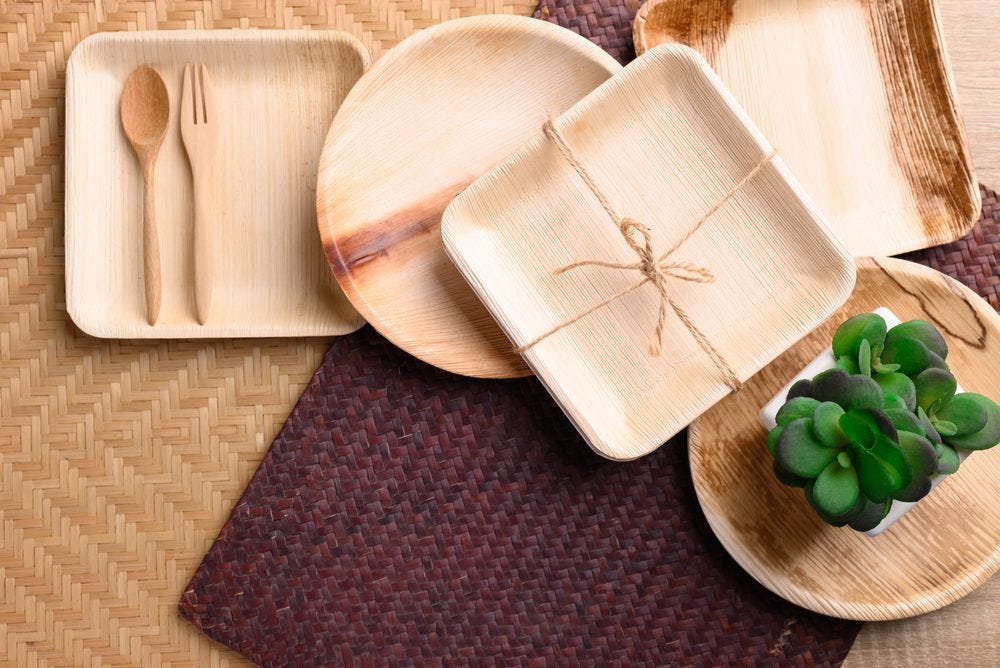Introduction
In a world where sustainability has become paramount, the utilization of eco-friendly alternatives has gained significant traction. Among these alternatives, palm leaf plates stand out as an excellent eco-conscious choice. Not only are they environmentally friendly, but they also possess several advantages over conventional disposable plates.
Understanding Palm Leaf Plates
What are palm leaf plates?
Palm leaf plates, also known as Areca plates, are dinnerware made from fallen leaves of the Areca palm tree. These leaves are collected, cleaned, and molded into various shapes and sizes to form plates, bowls, and trays.
How are they made?
The process involves collecting naturally shed palm leaves, which are then cleaned, heated, and molded using heat pressing techniques to create sturdy and durable plates.
Advantages of Palm Leaf Plates
Eco-friendly Nature
One of the most significant advantages of palm leaf plates lies in their eco-friendly nature. Being made from natural, renewable materials, they are entirely biodegradable and compostable.
Biodegradability
Unlike plastic or styrofoam plates that take hundreds of years to decompose, palm leaf plates naturally degrade within a few months, minimizing environmental impact.
Sturdiness and Durability
Despite their biodegradable nature, palm leaf plates are remarkably sturdy and durable. They can withstand a wide range of temperatures and are leak-proof, making them suitable for hot or cold foods.
Aesthetic Appeal
These plates possess a natural, rustic charm with their unique patterns and textures, adding an aesthetic appeal to any table setting or event.
Comparison with Other Disposable Plates
Comparison with Plastic Plates
In contrast to plastic plates that contribute to environmental pollution, palm leaf plates offer a sustainable alternative without compromising on functionality.
Comparison with Paper Plates
While paper plates are biodegradable, they often lack the durability and sturdiness that palm leaf plates provide, making the latter a more robust choice for various purposes.
Usage and Applications
Palm leaf plates find extensive use in events such as weddings, parties, and catering due to their elegance and eco-friendliness. Additionally, they serve as convenient and sustainable options for daily household use.
Cost-Effectiveness and Accessibility
Despite being eco-friendly, palm leaf plates are cost-effective and easily accessible, making them a practical choice for individuals and businesses alike.
Impact on the Environment
The utilization of palm leaf plates contributes significantly to waste reduction and minimizes the carbon footprint, aligning with sustainable practices and environmental conservation.
Challenges and Limitations
Availability
While gaining popularity, palm leaf plates might not be readily available in all regions, posing a limitation for widespread adoption.
Production Scale
Scaling up production to meet increasing demand while maintaining sustainable harvesting practices could present challenges for manufacturers.
Maintaining Palm Leaf Plates
To ensure longevity and hygiene, palm leaf plates require proper cleaning and storage. Washing with mild soap and air-drying is recommended, and they should be stored in a dry place away from moisture.
Conclusion
In conclusion, palm leaf plates stand as a sustainable and viable alternative to traditional disposable plates. Their eco-friendly nature, durability, aesthetic appeal, and minimal environmental impact make them a green choice for conscious consumers.
FAQs
- Are palm leaf plates microwave-safe?Palm leaf plates are microwave-safe for a limited duration, typically for heating food for a short period.
- Can palm leaf plates be reused?While they are sturdy, reusing palm leaf plates for extended periods is not recommended due to hygiene reasons.
- Are palm leaf plates suitable for all types of food?Yes, palm leaf plates are versatile and can hold both hot and cold foods without any leakage.
- Do palm leaf plates have any odor?No, these plates are odorless and do not impart any taste to the food served.
- Can palm leaf plates be composted?Absolutely, palm leaf plates are fully compostable and decompose naturally, contributing positively to soil health.
